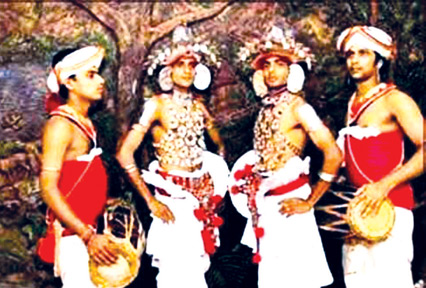Similarities between: Kandyan dance and Bharatha Natyam
by Subashini Pathmanathan
India and Sri Lanka are closely bound by historical, geographical,
cultural, and religious ties. Even languages and formation of letters
resemble each other to some extent. Silappathikaram, the Tamil classic,
describes Santhi Koothu which consists of four main Koothu forms,
namely, Chokam, Mei Koothu, Abhinaya, and Nadakam.Chokam is the pure
Nirtha dance.
The Mei Koothu consists of three main categories. Desi, Vaduku, and
Sinhalam.
|

Kandyan dancers |
Desi was a dance form of the Tamil country. Vaduku was a dance form
belonging to Telugu Desam, and the word Sinhalam, was apparently a
reference to a dance form belonging to Sinhala country.
Unfortunately apart from the word Sinhala, there is nothing about the
dance form in Silappathikaram. Even the great Tamil poet Subramaniya
Bharathi spoke of building a bridge to Sinhala Deepa.
Traditional Kandyan dance is a pure Nirtha dance firmly based on
Thala, Laya, and on Thandava Karana stance and based on rhythm.
Like Bharatha Natyam, the Kandyan dance was also danced in temples,
and temple festivals. But both dance forms enjoyed the royal patronage.
Today Bharatha Natyam has moved to public halls, from temples.
Processions
The Kandyan dance is still danced in temple peraheras (processions)
and sometimes in social functions. In ancient times Sathir was performed
in temples.
According Dr. M.D. Raghavan, one of the eminent research scholars on
oriental dances, earlier a dance form called Degge Natuma the dance of
Devalaya existed, such as Sadir, but today Degge Natuma is no longer in
existence.
In Bharatha Natyam many items have disappeared in the course of time,
but today all that remains are the references found in literary works.
Most of the Indian classical dance forms are based on Natya Sastra.
But those dances were influenced by regional, religious, cultural and
social traditions of each region. Kandyan dance appears to have grown
out of Natya Sastra, as there are discernible similarities between the
classical dance forms of India. In Bharatha Natyam the term Adavu (a
pure Nirtha) is confined to a step (a foot work), a body movement
accompanied with a hand movement, and hand muthras (hastas) based on a
particular thala and laya. In Kandyan dance the term Adavu is used for a
collection of pure Nirtha movements.
According to Dr. Raghavan, 'the most alluring of Kandyan dance is the
Ves'. He said, 'Among these are features which point to a certain
affinity in the Ves dancer's costumes, to the highly ornamental and
elaborate make up of the dancer in Kathakali of Kerala'.
There are many links between the Kandyan and Kathakali Dance'. Vannam,
one of the Kandyan Dances is the latest inclusion in the dance. There
are altogether 18 Vannams. Each Vannam is based on a separate theme. The
addition of Vannam to Kandyan Dance, provided a limited scope for some
Nirthya movements in Kandyan dance.
Like Bharatha Natyam, female dancers also play a significant role in
the Kandyan dance. Some of the similarities, between Kandyan Dance and
Bharatha Natyam are the half sitting position, separation of feet, (the
gap between the two legs are wider in Kandyan dance than in Bharatha
Natyam).
Knee facing two directions (right and left), stretching the arms at
the shoulder level, neck movements following the hand movements are some
of the similarities between the two classical dance forms.
In Bharatha Natyam, also certain pure classical pieces are seen (Allaripu
and Jetheswaram), but these pieces are anyhow interwoven with Classical
Carnatic music, Thala and Laya. However in Kandyan dance pure Nirtha is
interwoven with Thala, Laya and Rhythm.
In the Kandyan dance 'Udekki' is another important category of dance,
which derives its name from the drum, named Udukku. In Bharatha Natyam
also this drum plays an important role, because in the division of
Sabtha Thandava and in 108 Thandava karanas this drum Udekki is always
found in the hands of Thandava Murthi lord Nataraja, and the drum, is
called Udduku.
It is believed that all creation arose out of the sound of Udduku,
according to Thiru Manthiram 'thotram thudi thanil'. This Uddku also
plays an important role in Hindu rituals.
Terminologies
There are a lot of similarities in the terminologies between Bharatha
Natyam and Vannam. In Kandyan Dance, for instance GajagaVannama
(elephant), Nagavannama (cobra), Hanuman Vannama (god hanuman), Musaladi
Vannama, (rabbit), Mayura Vannama (peacock), are some of the common
terms found in both.
Some of the Vannams are based on Hindu mythology. Vannama in praise
of Lord Ganesha, and Kukkuda Vannama are some of them.
Bharatha Natyam, Odissi, Manipuri, Kuchipudi, and Kathakali are
deeply devotional and these dances are firmly based on Hindu mythology.
North Indian Classical dance form Kathak has a certain affinity between
a Kandyan dances. These are based on Thala and Laya and firm Nirtha
movements. Both these dance forms have fast and circular movements.
In Manipuri, East Indian dance male dancers wear turbans, and they
carry drums whilst they dance, as the male dancers in the Kandyan dance.
The North Indian classical dance form Kathak has certain affinity
with the Kandyan dance.For instance, both these are firmly based on
Thala and Laya, and firm Nirtha movements. Both these dance forms have
fast and circular movements. |

